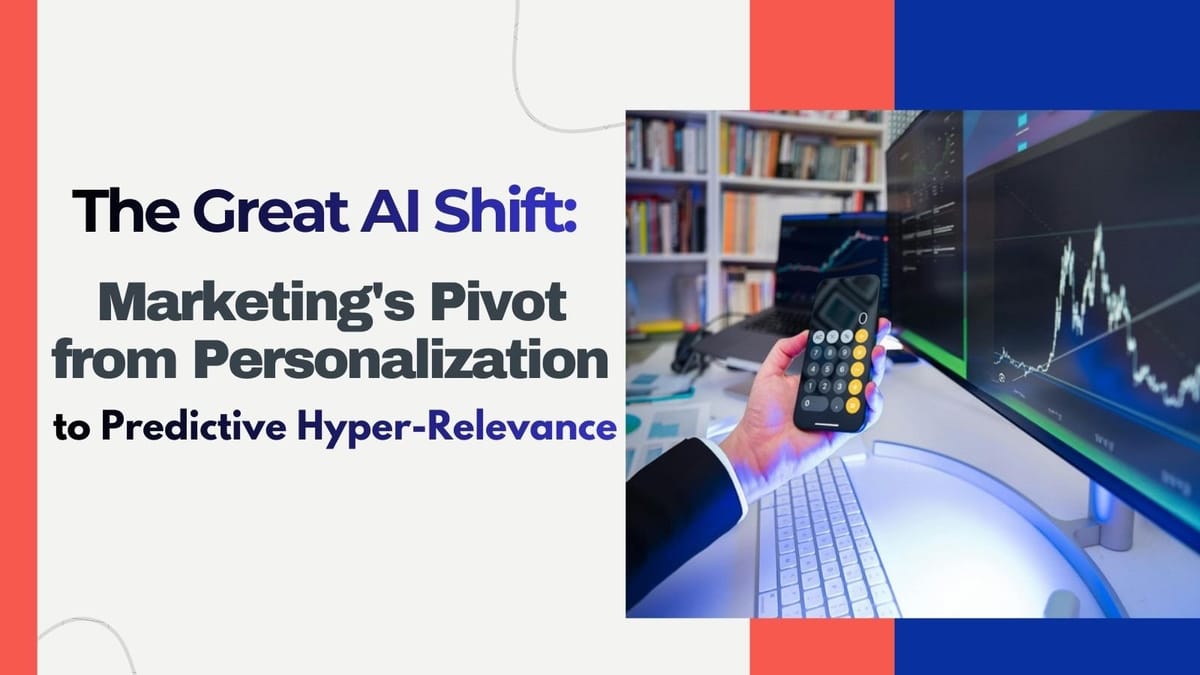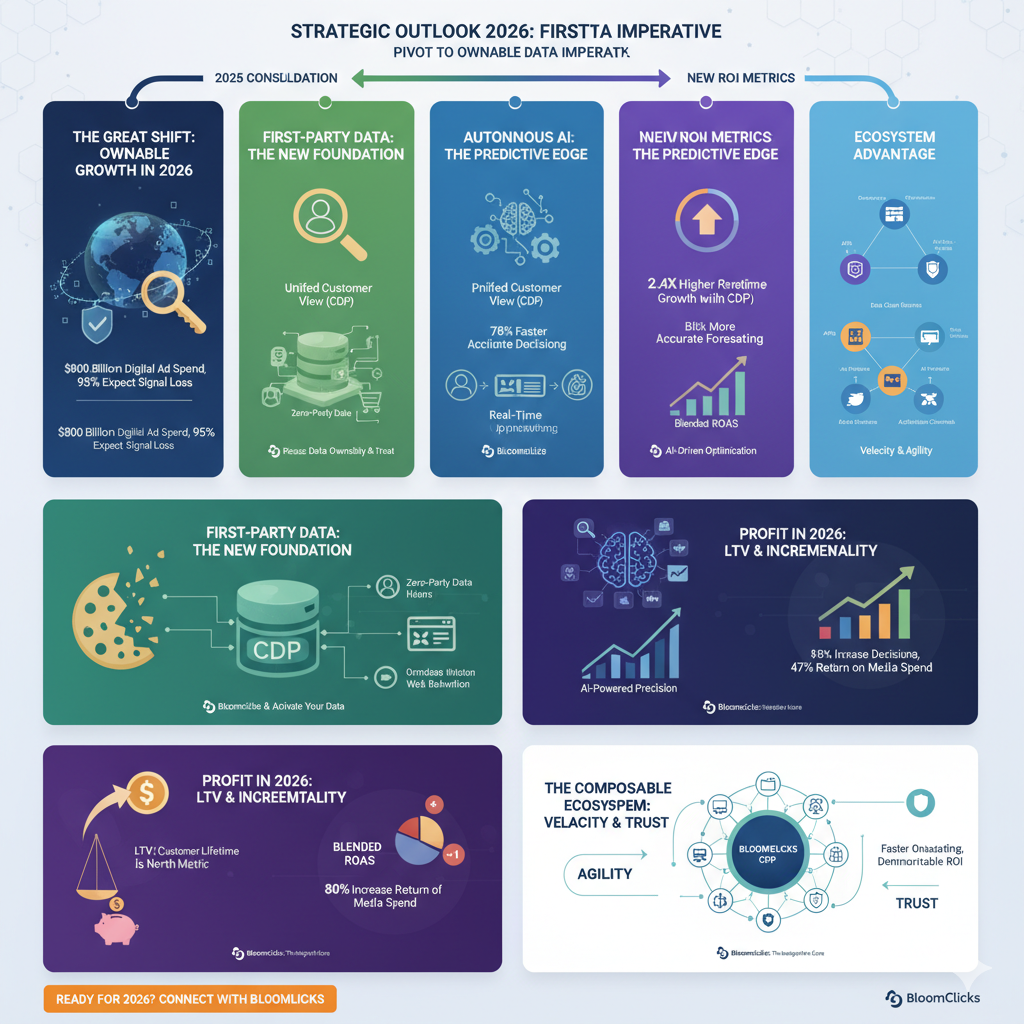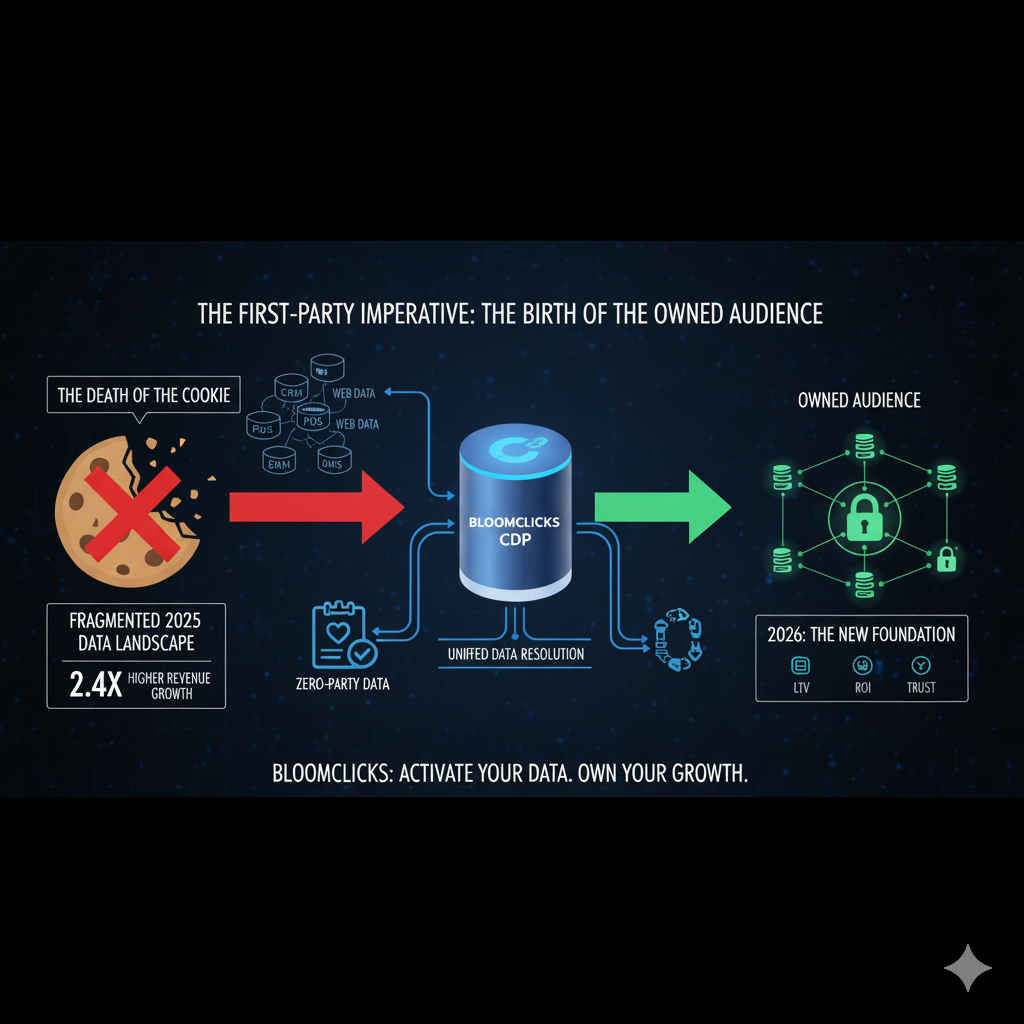The Great AI Shift: Marketing's Pivot from Personalization to Predictive Hyper-Relevance in 2026
The era of borrowed signals is over. Our 2026 Strategic Outlook reveals how leading enterprises are transforming the loss of third-party cookies into an unparalleled competitive advantage.

Navigating the Tectonic Shift to Ownable Growth
As we close Q4, 2025, the business narrative will forever be etched into remarkable history not by the heights of technological ambition or discovery but through the relentless discipline of consolidation.

Now, as we approach the end of 2025, the endless noise surrounding ephemeral trends has subsided with a new focus; what’s left is a stark and unshakeable truth about the digital and partnership marketing industry (the present and future).
The days of over-reliance on rented audiences and borrowed data are officially over. These last weeks of 2025 are the critical moment for business executive teams to stop reacting, solidify their gains and pivot from adapting to owning their future customer relationships.
Successful enterprises, I mean those who not just survive the privacy revolution but thrive within it, have moved swiftly to embrace First-Party Data as their most valuable asset of the future. This strategic pivot, driven by the definitive phase-out of third-party tracking, has indeed redefined the landscape of digital marketing strategy 2026.
This isn’t just some marketing headache; it’s a real existential challenge for businesses everywhere. Digital ad spending keeps rocketing up and is about to smash through the $800 billion ceiling next year. But here’s the twist: 95% of advertising leaders know signal loss is only going to get worse, thanks to stricter privacy laws and platform shakeups.
This paradox of massive spending coinciding with shrinking targeting capabilities means traditional and scattergun approaches are now prohibitively expensive and wildly inefficient.
The imperative for 2026 is clear: success will be measured by the ability to generate superior Marketing ROI from a diminishing pool of consented customer attention. This requires a unified data strategy, not just a toolset. This is where active players, such as Bloomclicks, have emerged not merely as vendors but as essential partners in navigation.
Bloomclicks is helping businesses and partners alike transition from reactive compliance to proactive, Privacy-First Marketing, ensuring that every data point collected fuels measurable Customer Lifetime Value (LTV). The following analysis is an exclusive blueprint for securing and scaling your 2025 victories into unassailable market positions in 2026.
The First-Party Imperative: The Core of 2025 Consolidation
The Death of the Cookies and the Rise of the Owned Audience: The 2025 marketing and advertising transition was catalyzed by the undenable reality: the decades-long reliance on third-party cookies for customer identification and attribution has been dismantled. This seismic shift, often termed "signal loss," has forced a dramatic consolidation in the marketing technology (MarTech) stack.
The winners were those who understood that the future of targeting and personalisation must be anchored in data collected directly and transparently from their customers.

This is the First-Party Data imperative; It’s the data a company collects from its direct interactions with customers, website behaviour, purchase history, app usage, and most importantly, zero-party data (ZPD) willingly shared by the customer (e.g., preference centre selections).
The market’s made it clear: Customer Data Platforms, or CDPs, aren’t just a bonus anymore; they’re the backbone of how big companies run things now. The global CDP Market is projected to grow from a valuation of $9.72 billion in 2025 to over $37 billion by 2030, reflecting a remarkable Compound Annual Growth Rate (CAGR) of more than 30%, but not surprising when you realise that siloed, fragmented data isn't working anymore.
What’s pushing this surge? Companies are desperate for a single, complete picture of their customers, and you just can’t get that if all your data is scattered across different platforms. Right now, large enterprises grab about 64% of the CDP market’s revenue. They’re pouring money into pulling all their data together, trying to turn raw information into real intelligence
Bloomclicks: Unifying Data, Unlocking LTV
The real challenge of the First-Party Imperative is not just about data collection alone but also data activation. Data warehousing can not generate revenue on its own, but requires a platform that can connect disparate identities, manage consent, and provide insights for activation channels in real-time.
Bloomclicks is positioned precisely at this nexus, serving as the connective tissue for sophisticated businesses and their partners.
- Identity Resolution: Bloomclicks utilises advanced identity graph technology to process raw, consented first-party data and stitch together anonymous browser sessions, known customer profiles, and offline purchase records into a single, comprehensive 360-degree customer view. This unification ensures that whether a customer interacts via mobile app, website, email, or in-store, their experience remains seamless and relevant.
- Zero-Party Enrichment: By prioritising Zero-Party Data (ZPD) collection, which includes preferences, intentions, and explicit needs. Bloomclicks helps global businesses make the shift from inferences to having direct, honest conversations with customers by asking customers what they want, which is the most reliable way to achieve higher marketing ROI in a privacy-sensitive world.
- Partner Data Exchange: Bloomclicks facilitates a compliant and transparent Second-Party Data exchange for its partners, moving beyond the opaque risks of third-party data. Businesses can securely share audience segments with consented parameters, creating valuable, high-quality, and pre-vetted co-marketing opportunities that drive incremental reach without compromising privacy standards. This mechanism is an engine for partner ecosystem success, creating a new, accountable revenue stream that directly supports the business’s Digital Marketing Strategy 2026.
Moreover, businesses that effectively leverage unified customer data have seen an average increase of 80% in return on media spend (ROAS) over five years. This financial outcome underscores the importance of the strategic investment in first-party infrastructure made in 2025 and beyond.
The Privacy Paradox: Turning Compliance into a Competitive Edge
The regulatory landscape is marked by the continued influence of GDPR and CCPA, including the swift introduction of various U.S. state laws in 2025, such as the Maryland Online Data Privacy Act (MODPA) and emerging universal opt-out mechanisms. These developments are fundamentally reshaping marketing practices moving forward.
By 2026, these laws will be fully in effect, requiring businesses to obtain granular consent, engage in detailed data mapping, and uphold the rights to correction and deletion of personal data. Initially perceived as a financial burden, this regulatory responsibility is now recognised by market leaders as a critical competitive differentiator.

Privacy-First Marketing is more than just a compliance checklist; it serves as a signal of trust.
- The Trust Premium: Customers are becoming more selective about the organisations with which they share their data. Transparency in data collection, clearly explaining what data is collected and why it is essential, will lead to acquiring higher-quality data. Research indicates that consumers who consciously opt in to personalised experiences are significantly more engaged and exhibit a higher Customer Lifetime Value (LTV).
- Operational Excellence: The growing demand for auditable consent records and real-time preference management has prompted companies to invest significantly in robust Consent Management Platforms (CMPs). Bloomclicks’ integrated consent governance features ensure that every activation is aligned with the customer's most recent preferences, thereby eliminating compliance risks and directing spending exclusively towards authorised, high-intent individuals.
Audit Your Foundation for 2026 Readiness
Your reliance on third-party data is now a ticking clock. Don't let your data strategy become obsolete before 2026 even begins.
Click Here to Connect with a Bloomclicks StrategistWe urge all executives to perform a comprehensive First-Party Data Audit by December 5th and secure your proprietary data graph. The fastest path to sustainable Marketing ROI is through ownership.
AI-Driven Personalisation and the 2026 Outlook
The transition to a privacy-first ecosystem The deprecation of third-party cookies, and stringent data regulations mark the transition to a privacy-first personalisation at scale and adoption of predictive performance metrics that consider factors beyond immediate clicks.
- AI-Driven Personalisation at Scale
In a world without omnipresent third-party identifiers, the challenge is maintaining relevance without intrusive tracking. AI becomes the central mechanism for bridging this data gap. - Moving Beyond Simple Segmentation
AI-driven personalisation goes far beyond basic segmentation (e.g., users who bought 'X' get an ad for 'Y'). It involves utilising machine learning models to analyse first-party data (historical purchases, website behaviour, known demographics) and contextual signals (time of day, device, campaign touchpoint) to create real-time, dynamic customer profiles.
This allows brands to:
- Predict Intent: Determine what a user is most likely to buy, read, or engage with next, even on their very first visit.
- Optimise Experience: Serve hyper-relevant content, product recommendations, and offers across owned channels (website, email, app) and addressable advertising environments (retail media networks).
- Ensure Consistency: Maintain a single, cohesive customer experience, whether the interaction occurs on a desktop browser or a mobile application, providing a seamless brand journey that builds trust.
Scaling personalisation requires operational efficiency, using AI to automate the thousands of micro-decisions needed every second, from bid optimisation in media buying to dynamic creative generation.

Redefining Success: LTV and Predictive Modelling
Traditional metrics like Cost Per Acquisition (CPA) and Return on Ad Spend (ROAS) often prioritise short-term gains and are ill-equipped to measure the true value of a customer in an increasingly fragmented journey. The new measurement framework is anchored by two forward-looking metrics.
1. Customer Lifetime Value (LTV)
Customer Lifetime Value (LTV) becomes the ultimate benchmark of marketing performance. It shifts the focus from the single transaction to the total revenue a customer is expected to generate over their entire relationship with the brand. By optimising campaigns for LTV, businesses incentivise the acquisition of higher-quality customers who exhibit better long-term retention and higher average order values.
AI models are critical here, as they provide an Estimated LTV (eLTV) score for prospects early in the funnel, allowing marketers to invest more confidently in channels that deliver durable customer relationships, not just cheap clicks.
2. Predictive Modelling and Incrementality
To accurately attribute results without third-party cookies, brands must rely on Predictive Modelling. This includes statistical and probabilistic models that use aggregated data, clean room technology, and historical conversion patterns to fill in the measurement gaps.
Success is measured by incrementality: confirming that the marketing effort truly caused a desired action, rather than simply being present when the action occurred. This requires continuous A/B testing, geo-testing, and rigorous statistical analysis to isolate the true impact of media investment.
This approach reduces reliance on one-to-one tracking, making marketing inherently more compliant and accurate.
The 2026 Outlook
By 2026, the digital advertising landscape will fully solidify around the AI-driven, privacy-centric models currently in development.
- Data Clean Rooms Become Central: Secure Data Clean Rooms (DCRs) will move from niche tools to mandatory infrastructure for any brand engaging in advanced media planning or measurement. They will be the primary mechanism for matching and analysing first-party data against publisher or retail data without exposing raw Personally Identifiable Information (PII).
- The Rise of Retail Media Networks (RMNs): RMNs will continue their aggressive expansion, utilising their vast first-party shopper data to become dominant, measurable advertising channels. Brands will heavily shift budget into these networks, favouring environments where known customer identity ensures precise targeting and attribution.
- AI-as-an-Engine: AI will transition from being a supporting tool to the core decision-making engine of marketing operations. Budget allocation, creative testing, bidding strategies, and predictive forecasting will be fully automated, managed by specialised AI platforms that optimise directly toward LTV and business growth metrics, rather than platform-specific KPIs. The role of the human marketer will evolve into strategic oversight, prompt engineering, and model governance.
- Consolidation of Identity: Solutions based on authenticated identity (such as logged-in users, hashed emails, and universal IDs) will gain dominance. Brands that successfully prioritise customer login and build robust first-party data lakes will possess a clear competitive advantage over those still relying on aggregated or inferred data.
The Financial Mandate: LTV, ROAS, and the New Attribution Model
The strategic pivot to First-Party Data is fundamentally a financial one. As platforms reduce measurement signals and privacy walls rise, the cost of acquiring bad data or relying on outdated, imprecise data has become the single greatest threat to sustained profitability.
By the close of 2025, successful organisations will have recognised that the old models of attribution are obsolete; financial victory in 2026 will be defined not by ad-platform metrics, but by internal, durable, and predictive financial indicators.
The High Cost of the Obsolete Stack
The primary financial drain in the post-cookie environment is inefficiency born from data fragmentation. Companies today are using 230% more data than they did a few years ago, yet a significant portion of this data is either siloed, low-quality, or unusable due to a lack of consent. This results in wasted ad spend due to:
- Phantom Targeting: Ad impressions served to irrelevant or already-converted customers.
- Inaccurate Frequency Capping: Over-messaging customers across channels, leading to brand fatigue and regulatory risk.
- Misaligned Budgets: Allocating disproportionate spend to channels that report high platform ROAS but deliver low Customer Lifetime Value (LTV).
The solution is shifting the financial spotlight entirely onto the customer's value rather than the campaign’s immediate cost.
LTV is the New North Star
For the Digital Marketing Strategy 2026, Customer Lifetime Value (LTV) has become the definitive metric for two reasons: it rewards long-term retention, and it is inherently reliant on high-quality First-Party Data. When businesses optimise their acquisition models for LTV, they prioritise personalisation, loyalty, and customer service, the very elements that build a durable, owned audience.
The LTV and Personalisation Dividend
The correlation between data quality, personalisation, and LTV is now undeniable. Research from late 2025 indicated that 94% of marketers who successfully deploy personalised content report a boost in sales. This is because deeply personalised experiences, which are only possible with a unified first-party profile, drive repeat purchases and loyalty.
- Infographic Requirement: When a brand, powered by its CDP (like Bloomclicks), can use purchase history, explicit preference data (Zero-Party Data), and behavioural signals to tailor a product recommendation or an upsell offer, the results are powerful:
- Increased AOV (Average Order Value): Recommendations are more relevant, prompting larger immediate purchases.
- Improved Retention Rates: Personalised post-purchase journeys keep customers engaged and loyal.
- Reduced Churn: Anticipating customer needs and addressing potential pain points proactively based on predictive models.
Bloomclicks’ advanced data ingestion and identity resolution layer ensures that LTV calculations are accurate and robust, providing a single source of truth that transcends individual channel performance reports. This enables finance and marketing teams to agree on a unified, high-value acquisition cost (CPA), knowing that the long-term LTV justification is sound.
The New Attribution Model: From Last-Click to Incrementality
The reliance on the last-click model, which heavily favoured performance channels like Paid Search (PPC), is rapidly being superseded by a more complex, accurate framework based on modelled attribution and incrementality testing.
The Rise of Blended ROAS
Instead of celebrating a 200% ROAS from a single paid search campaign (which traditionally returns $2 for every $1 spent), the strategic focus in 2026 is on Blended ROAS.
This calculation considers all revenue generated, including organic, direct, and email/CRM-driven revenue, from customers initially acquired through a specific media channel.
By utilising Bloomclicks to unify data across paid media, organic channels, and owned customer data systems (CRM/Email), companies can finally see the true cross-channel lift:
- Email Marketing, a channel that yields one of the highest true Marketing ROI metrics (often cited at over 3,600%, or $36-$40 for every $1 spent), is finally attributed correctly in the acquisition journey, justifying greater investment.
- Content Marketing, which is shown to generate three times more leads than traditional advertising and costs 62% less, gets the credit it deserves when its impact on organic search and nurtured LTV is accurately measured.
The Role of Predictive Modelling in Attribution
In the absence of deterministic third-party cookies, the gap is filled by Probabilistic and Statistical modelling. This is where AI excels, leveraging massive first-party datasets to accurately predict the likelihood of a conversion based on known customer profiles and the sequence of marketing exposures.
Bloomclicks offers proprietary tools that leverage its unified data foundation to perform sophisticated analysis:
- Media Mix Modelling (MMM): Used to simulate different budget allocations and understand the optimal spend across high-level channels (Social, Search, Broadcast, Retail Media).
- Lift Testing/Incrementality: Continuous testing to prove that a specific campaign drove a statistically significant increase in conversions that would not have happened otherwise.
This shift means that instead of chasing low-quality conversions for a high platform ROAS, businesses are investing in channels and segments that have a proven, measurable, incremental impact on high-value LTV customers.
Shift Your Metrics, Secure Your Budget
Stop funding campaigns based on vanity metrics. 2026 is the year when your data must deliver proof of financial incrementality.
Click Here to Connect with a Bloomclicks StrategistRequest a personalised Bloomclicks LTV Diagnostic to identify the acquisition channels and customer segments that deliver your highest Customer Lifetime Value (LTV). Transform your 2025 data foundation into a 2026 profit centre.
The Ecosystem Advantage: Partnerships, Velocity, and Strategic Consolidation
As we solidify the gains of 2025 and plan for a financially optimised 2026, the final strategic requirement is to build an ecosystem that is both robustly connected and highly flexible. This means moving away from single-vendor "suites" and embracing the Composable MarTech stack, centred around a powerful CDP.
The Composable Stack: Freedom to Optimise
The complex requirements of Digital Marketing Strategy 2026, combining AI-driven personalisation, precise LTV calculation, and strict privacy governance, cannot be met by a single, monolithic software vendor.
The consolidation seen in 2025 prioritised agility, leading to the clear choice of a composable architecture:
- Unified Data Core: A central CDP (e.g., Bloomclicks) acts as the source of truth for first-party data.
- Best-of-Breed Activation: Specialised tools (e.g., personalised email sending, advanced bidding platforms, content delivery networks) are integrated via APIs to execute specific functions.
This model provides maximum velocity, the ability to deploy new technologies or discard underperforming ones quickly, and ensures the business is never locked into a single vendor's limitations. By utilising a flexible data structure, companies can scale their data-driven initiatives rapidly and effectively.
Bloomclicks: The Active Player for Businesses and Partners
A central challenge for many businesses in 2025 was managing the transition complexity. This is where Bloomclicks distinguished itself as an active player for both enterprise clients and their crucial agency and technology partners.
- Empowering Businesses with Clean Data
For the client, Bloomclicks provides the governance and unification required for financial stability. Its platform directly addresses the data quality issues that plague traditional systems, ensuring that:
- Consent is Auditable: Real-time logging of customer consent status, making activation campaigns compliant across jurisdictions.
- Data is Deduplicated: Eliminating redundant profiles and ensuring accurate LTV calculations.
- Segmentation is Dynamic: Providing instant access to high-value, high-intent segments for immediate activation via paid media or owned channels.
- Accelerating Partner Success
For the ecosystem of agencies, consultants, and integration partners, Bloomclicks is the engine of service delivery for Digital Marketing Strategy 2026. By building services on top of the Bloomclicks identity graph, partners gain:
- Faster Onboarding: Access to a pre-cleaned, unified data source drastically cuts the time required for data ingestion and project setup.
- Proof of Value: The ability to perform incrementality testing and LTV analysis, made possible by the platform's robust attribution tools, allows partners to demonstrate clear, undeniable Marketing ROI to their clients.
- High-Value Services: Partners can move away from low-margin implementation work to high-margin strategic services like predictive modelling and advanced personalisation, ensuring their own business consolidation and growth.
This active enablement of the partner ecosystem is a core differentiator, transforming the platform from a back-office tool into a strategic engine for industry-wide innovation.
The Final Consolidation and Outlook for 2026
The final weeks of 2025 represent the last opportunity to fully consolidate the necessary data and technology infrastructure before 2026 demand accelerates. The Digital Marketing Strategy 2026 will be a fierce competition for customer attention, governed by strict rules of transparency and powered by sophisticated AI.
Those who invested strategically in their First-Party Data foundation—and leveraged partners like Bloomclicks to unify that data- have secured their competitive standing. They are now poised to achieve higher LTV and superior Marketing ROI by deploying AI-driven personalisation at a scale their less-prepared competitors cannot match.
The era of borrowed signals is over. The era of Owned Audience is here. The time for strategic finalisation is now.
Secure Your 2026 Competitive Advantage
Your competitors are moving from planning to deployment. Don't let your data strategy lag. Take immediate action to transform your unified first-party data into a predictive, revenue-generating machine.
Schedule a Bloomclicks 2026 Readiness Workshop Today and finalise your integration to ensure every dollar spent next year maximises your Customer Lifetime Value (LTV). The future of marketing is owned, and the time to stake your claim is now.
Start Your Journey to Unassailable Marketing ROI.
Share This Strategic Outlook
Help your network pivot from obsolete metrics to LTV-driven growth. Click below to share this report and drive the conversation.





